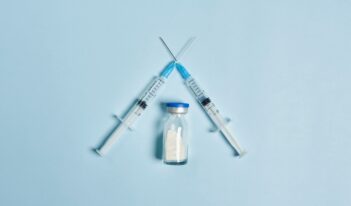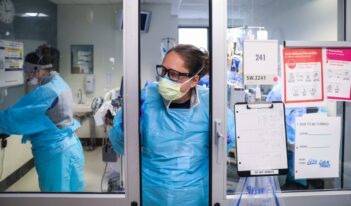
Scholar claims that regulatory sandboxes such as emergency use authorizations boost innovation, but at a cost.
The World Health Organization reports that COVID-19 has caused over 194 million confirmed cases and over 4 million deaths worldwide. In the global fight against the virus, fast development of vaccines, therapeutics, and diagnostic testing has been critical to prevent even more catastrophic loss of life. Based on pre-vaccine infection and mortality rates, many more deaths would have occurred if normal technology development protocols had been followed.
In a forthcoming article, Jacob Sherkow of the University of Illinois College of Law argues that the U.S. Food and Drug Administration’s (FDA) emergency use authorizations were a type of “regulatory sandbox”—a “safe space” in which regulations are relaxed on a case-by-case basis to speed up innovation.
Sherkow explains that ensuring public safety is the primary objective of traditional regulation. He argues that this objective prompts government agencies to protect the public by locking in status quos in an effort to prevent new risks. Sherkow explains that sandboxes, by contrast, allow experimental flexibility while still providing some limitations. Well-designed sandbox programs also require developers to document how their new innovation performs in unpredictable conditions of the real world and to share data with the agency for real-time monitoring.
Sherkow also suggests that sandboxes have certain process elements that make them effective: procedures to adapt regulation in response to input from industry; authorizations that are broad enough to cover iterations of new technologies; and limitations on scope and duration.
The COVID-19 pandemic created a perfect scenario for a sandbox procedural approach in place of typical FDA governance. The normal process for FDA drug approval and authorization can take years, cost millions of dollars, and require clear demonstration that new drugs are safe and effective. During a national emergency, however, Section 564 of the Food, Drug & Cosmetics Act allows the U.S. Secretary of Health and Human Services to authorize drugs under different rules. Such authorizations are called emergency use authorizations (EUAs). Under an EUA, FDA may grant limited authorization, but not full approval, to new drugs.
Sherkow describes several characteristics of EUAs that qualify them as a type of regulatory sandbox. First, FDA may authorize a drug under more relaxed evidentiary standards if there is a “reasonable belief” that the product will be effective. Sherkow explains that, while the minimum evidentiary standard for the “reasonable belief” threshold is set at a “totality of scientific evidence,” the risk-benefit analysis part of the framework allows FDA to tailor its requirements for EUAs to the specific situations in which a new drug or therapeutic will be used. For instance, Sherkow describes how FDA still required extensive pre-EUA human clinical trials for vaccine safety, recognizing that maintaining public trust in the agency is an important part of national public health strategy.
Second, to qualify as a regulatory sandbox, a risk-benefit analysis must be made in the context of the emergency situation. Third, if FDA has already approved adequate alternate drugs, then a new drug cannot be authorized under an EUA. Finally, the Public Readiness and Emergency Preparedness Act limits tort liability against companies that produce and distribute products under an EUA.
Even if the COVID-19 EUAs can be considered regulatory sandboxes, Sherkow worries that the unique circumstances of the pandemic limit how useful the experience will be for the implementation of future regulatory sandboxes. Sherkow argues that regulatory sandboxes, including the COVID-19 EUAs, can diminish public trust in government agencies. He reported that polling data suggests that Americans are both skeptical of the vaccines and less confident in FDA because of perceptions about the transparency of vaccine data.
EUAs may come with other costs as well. Sherkow notes that the existence of a regulatory fast-track environment can be difficult to contain when public pressure for solutions is mounting. For instance, political pressure from the White House in 2020 to support hydroxychloroquine, convalescent plasma, Regeneron’s antibody therapy, and vaccines made legitimate evaluation of scientific evidence more challenging.
Sherkow also notes that the pressing need for fast innovation during the COVID-19 pandemic made the use of EUAs exceptional and claims that the need for innovation in most other areas is not as critical. In addition, Sherkow describes FDA itself as a “uniquely protective institution” with a broad reach and a unique power to influence product development even without taking formal agency actions.
Sherkow nonetheless argues that the use of EUAs demonstrates that sandbox approaches can be beneficial in other areas where real-world experimentation can help hasten innovation.
In the end, the EUAs are only temporary authorizations. Companies producing vaccines and other drugs under EUAs will still need to go through the traditional FDA approval process to keep producing them. Some companies, such as Pfizer and Moderna, have already submitted Biological License Applications to FDA seeking full approval of their COVID-19 vaccines. Full approval would allow the companies to market their vaccines directly to consumers.



